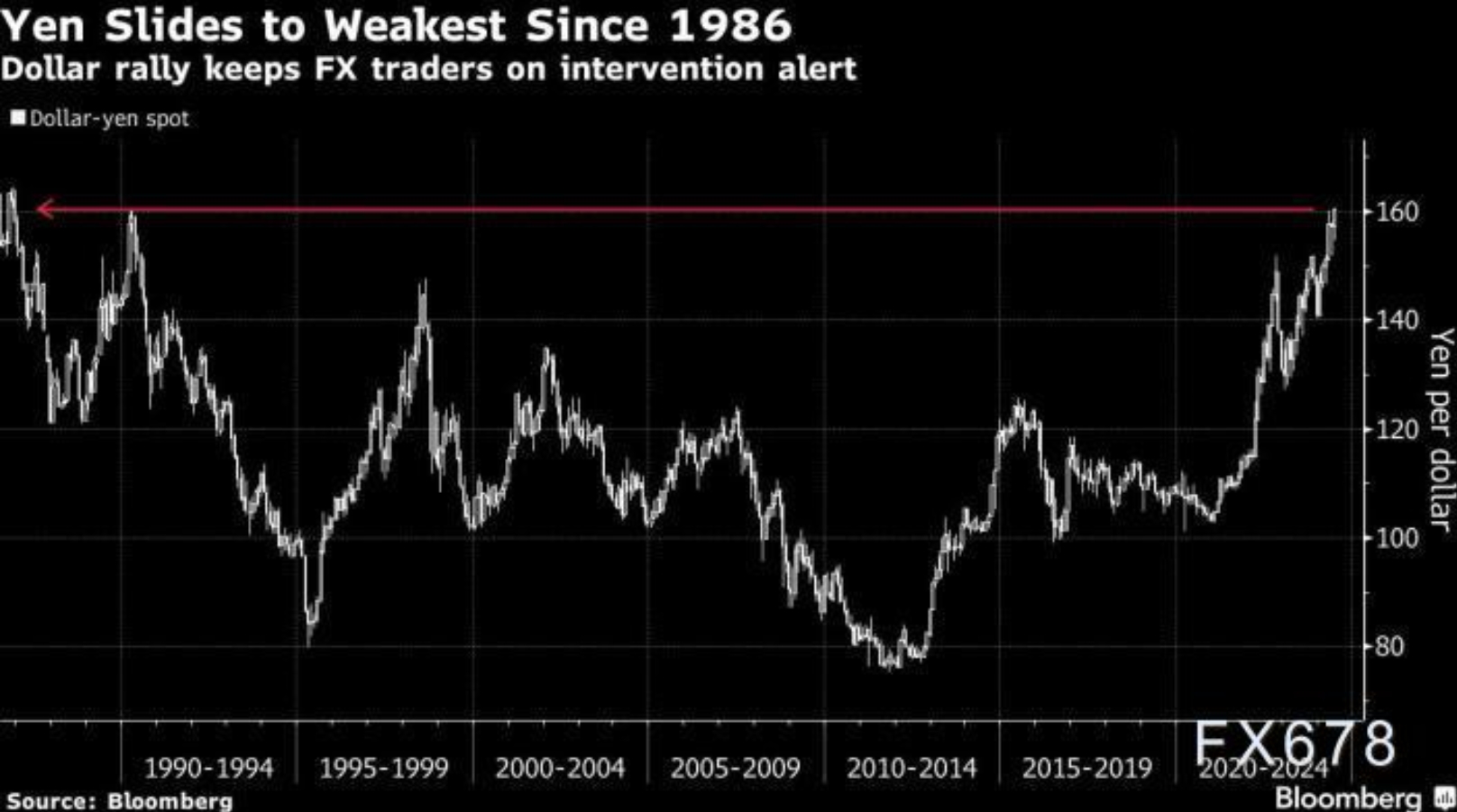The US dollar rose above the 160 mark against the Japanese yen, reaching a nearly 40 year high
As the Japanese yen continues to rapidly fall below milestones, the Japanese authorities face a harsh reality: unless the Federal Reserve abandons its long-term policy path of maintaining high interest rates, the decline of the yen will not stop. And the Federal Reserve is powerless to do so.

Global investors generally recognize how the high borrowing costs of the United States can support the US dollar and affect other regions of the world. In the global currency market with a daily trading volume of up to $7.5 trillion, the sustained sharp decline of the Japanese yen is an extreme manifestation of the dominant position of the US financial system.
"All of this is related to the Federal Reserve. Maintaining high interest rates for the long term will attract funds to flow into the United States and keep the US dollar strong," said Andrew Brenner, International Head of Fixed Income at NatAlliance Securities LLC. "For Japan," this is a problem. "
On Wednesday (June 26th), the dominant position of the United States in global financial markets was fully demonstrated. A key indicator of the US dollar has closed at a new high so far this year, putting pressure on other currencies around the world. The US stock market is about to enter another strong quarter, and the US Treasury Department has easily found buyers for its $70 billion auction of bonds.
Japan's response
The US dollar rose 0.7% against the Japanese yen on Wednesday (June 26) to 160.87, a new high since 1986, before narrowing its gains and hovering around 160.70, exceeding the level of official intervention in the market in April. The euro rose to a historic high of 171.80 against the yen.
Among these trends, Masato Kanda, the highest currency official in Japan, reiterated that the authorities are urgently monitoring the foreign exchange market and will take appropriate measures as needed.
However, the efforts made by Tokyo officials to support the yen have not been effective so far. Since Asian countries invested a record 9.8 trillion yen (over 60 billion US dollars) into the foreign exchange market, the yen has continued to weaken in the past few weeks - strategists say further intervention may also be ineffective.
"I believe that these measures will not be effective unless the Federal Reserve truly relaxes monetary policy. From a broader perspective, you must reduce Japan's demand for the US dollar. Either make long-term interest rates high enough or make US interest rates low enough. But neither of these situations has happened," said Bob Savage, head of market strategy and insights at Bank of Mellon Capital Markets in New York
major factor
The data released by the US Commodity Futures Trading Commission on Monday showed that asset management companies are betting on a decline in the yen, with last week being the most bearish week for asset management companies since 2006. The huge interest rate gap between Japan and the United States is the main factor contributing to the decline of the Japanese yen this year.
At the beginning of this year, traders expected the Federal Reserve to launch a series of interest rate cuts, leading major central banks around the world to adopt loose policies, while the Bank of Japan chose to abandon its ultra-low interest rate policy. However, the strong US economy and high inflation have allowed the Federal Reserve to maintain interest rates unchanged, while the Bank of Japan has raised rates slightly.
Kathy Jones, Chief Fixed Income Strategist at Credit Suisse, said, "The yen should have risen with Japanese interest rates this year." But now, "the wait is still ongoing."
Future catalysts
On Friday, the Federal Reserve's most important US inflation indicator will become the next important catalyst for the yen's trend. Economists predict that core personal consumption expenditure inflation (excluding indicators of volatile food and energy categories) will slow down, which may strengthen the Federal Reserve's rationale for reducing borrowing costs this year.
Japan faces significant risks. Citigroup estimates that the country will have $200 billion to $300 billion in funds to support any further intervention, which will include selling its cash reserves in the US dollar and other currencies, and even selling government bonds from around the world to purchase the Japanese yen.
Market perspective
Bloomberg forex strategist Vassilis Karamanis said, "If the US dollar breaks through 163 against the Japanese yen this week, it may prompt the Japanese Ministry of Finance to take action, as this will result in actual volatility exceeding 10% and the currency being about 10 yen higher than the low point on May 16th."
Dominic Kondam, head of strategy at Mizuho Securities, added that as the Bank of Japan normalizes monetary policy, any intervention is more aimed at "slowing down the process of the yen finding its final bottom.". He said, "The problem they are facing is that they are intervening in the wrong direction. Their reserves are limited and they cannot spend hundreds of billions of dollars to defend the currency."
Tips:This page came from Internet, which is not standing for FXCUE opinions of this website.
Statement:Contact us if the content violates the law or your rights
